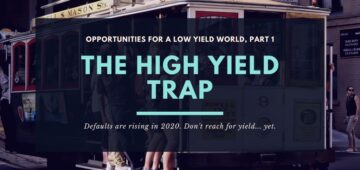As we enter the seventh week of shut-downs, we are going to share our Coronavirus Market Update. Let’s look at the numbers and talk about stocks, unemployment, interest rates, oil prices, and government assistance programs.
1. Market rebound
From a low of 2237 on the S&P 500 Index on March 23, we are up 27% to 2836 as of Friday’s close. This is a remarkable bounce. Now the market is down only 12% year to date. I have a couple of thoughts on this:
- The rebalancing trades I placed in March consisted of selling bonds and buying stocks. Overall, those trades have been profitable and beneficial for clients. At the time, it did not feel good to buy stocks in the midst of such carnage. Rebalancing is usually a contrarian action; we buy when markets are down and sell when markets are up.
- If you thought the best move in March was to bail out and increase cash, it didn’t work. The market bottom will often be significantly ahead of an economic bottom. The market is a leading indicator. You won’t get an All-Clear to come back into the market.
- Was that THE bottom? Will we retest lows? I don’t know and it is not predictable. We have up come very far, very fast and as I will discuss below, we are only seeing the tip of the iceberg of the economic fallout. The market has had a 26% move in a month and I am going to rebalance again. Because we made deliberate trades in March, some portfolios may now be overweighted in stocks after this quick rebound. Those trades will happen this week.
2. Unemployment
There have been 26 million unemployment claims since the start of the Coronavirus. Approximately one out of six workers have been laid off and this number excludes most independent contractors. A report from the Federal Reserve Bank of Boston projects that 18% of homeowners and 36% of renters in New England will be unable to make their housing payments.
These levels of unemployment have not been seen since the Great Depression, when unemployment reached 24% in 1933. This will have a ripple effect on consumer spending, defaults on loans, mortgages, and credit cards, the auto industry, real estate prices, and so on. For the economy, this will likely have an impact for at least 12-18 months.
Markets go up when there are more buyers than sellers. That’s it. So, the action over the past month tells you that there is money on the sidelines, in spite of rising unemployment. The wealthy are less wealthy, but they are rebalancing and looking for profits in a strong market. They are also bargain shopping for great companies which may have been trading at multi-year lows in the past month.
3. Oil prices
This week, massive options selling coupled with no buyers caused the May futures contracts for Crude Oil to sink into negative prices. With people not travelling, demand for oil has plummeted. A few countries have flooded the market with oil and current daily production exceeds demand by 20 million barrels a day. Luckily, Texas is more diversified today than just oil companies, but oil companies are taking a hit.
Oil Companies which have borrowed a lot of money for expansion or acquisition are in trouble and may fail. This is creating fear in the bond market, where the spreads on corporate bonds have widened significantly. At the beginning of the year, corporate bonds were trading at yields very close to Treasuries. Not so today, and that creates opportunity to buy bonds of companies with strong balance sheets.
4. Interest Rates
Treasury bill interest rates fell to zero last month, to match zero rates in Europe and Japan. Today, those levels have increased slightly, but remain around 0.13% to 0.20% for maturities of two years or less. Take aways:
- You can’t fund your retirement with Treasury bonds today – the returns are too low. These rates are way below historical inflation, and even if we are in deflation for the next year, the returns just don’t work with most people’s required rate of return in their retirement projections.
- You can move from Treasuries to CDs to Fixed Annuities to increase your yield while maintaining a guaranteed, safe return. Treasury rates are being manipulated by Central Banks. As governments take on trillions of new debt, they somehow become a safer credit and their interest rate falls to zero? This is not what a free-market looks like and it is penalizing the heck out of savers and retirees.
- Individual investors will choose not to own Treasuries. The Fed wants to push investors out of risk-free assets and into risky assets like stocks or real estate.
5. Government Programs
Individuals have been receiving their $1200 stimulus checks. Many small businesses who applied for the Paycheck Protection Program have been shut out as demand for those loans greatly exceeded the $349 Billion allocated. I’ve heard that only companies who applied on the very first day received funds. Apparently, the Treasury favored community banks and therefore you were actually less likely to receive the loan if you applied through one of the large national banks. However, if you have an application pending, Congress is going to fund further loans. Thank you to everyone who reached out to me to discuss their PPP application.
The SBA also offered the Emergency Income Disaster Loans (EIDL). They announced a week ago that they were no longer accepting applications. I applied for this program about 18 days ago and still have not received a reply. They originally said applicants would receive the money in three days. I sent an email about my application and received back a form letter saying they were still processing applications in the order received. Hopefully, this will work! If you applied for any government assistance for your business, please shoot me an email and let me know where things stand for you.
Final Thoughts
The market has had a great rebound in April and it is a big relief. Losses have been cut by 2/3 and many investors have been buying. From my perspective, investors seem less panicked this year than they were in 2000 or 2008. As a result, most have understood that they need to ride things out and that this will pass.
We rebalanced in March and that worked well. It is part of our discipline and we will look at rebalancing again now that we have recovered 26%. This will be done on a portfolio by portfolio basis and will include a careful examination of the tax implications of any trades. Most of the March trades harvested losses, so we can now realize short-term gains up to those levels.
The economy clearly isn’t out of the woods. Unemployment will probably increase in May. These numbers will grow and many families are going to have to tighten their belts. There is a tremendous amount of government support being directed at impacted industries and small businesses. Hopefully, those funds will start to reach companies soon. Investors need to be patient and have a disciplined plan. We will continue to focus on your long-term success and look at ways to reduce unnecessary risk.







